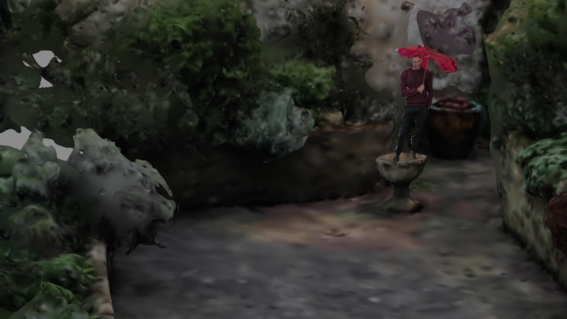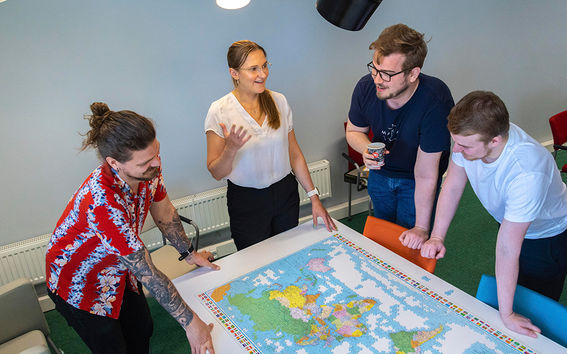I enjoy everything to do with spatial analytics (I love the broad range of applications; the physical sciences, social sciences, industry application, and so on) and satellite remote sensing - there’s something magical about the images we can look at. I have some concerns about the ethics and governance, but nonetheless, it’s special to be able to use that information and, I hope, do some good with it, whether we’re monitoring a single stand of trees in a forest or the entire earth system.
When I was studying full time, I was working really hard. I don’t have an engineering background so for every assignment I was playing catch up. The first task was to get an overview of a topic – just enough to work out what I needed to know and what I didn’t need to know, and the depth to go into. What did I need to know for the assignment? What did I need to know generally? Then once I’d done that, and the background stuff (as well as googling and asking for a lot of help from course mates and tutors), I would start the assignments. I knew that if I didn’t keep on top of things I’d get irrevocably behind, so I used a project management tool (Trello) to organize my assignments and break them down into smaller tasks with deadlines.
These days I’m working, so studying takes place in the evenings and weekends. I have to be even more strict about time management, but luckily, I’m not playing catch up so much anymore!
Over the last year I spent six months in South Sudan running primary data collection projects, and then in April I came back to Finland to work in the Water and Development Research Group, which is also in the School of Engineering. I was writing code for a crop optimization model called OptoFood. The code takes lots of geographic information, such as rasters, and formats them for input into a linear optimization. It was a lot of fun getting deep into some of the ways geographical data can be used and working out how to bring really diverse data into some common formats.
Working in the Water and Development Research Group has been a lot of fun. I liked my colleagues a lot and the subject matter was fulfilling. The research is very relevant to global challenges (climate change, food and water scarcity, operating in safe planetary boundaries), and I got to use some of the things I’ve learnt in the Geoinformatics programme. The work itself was very self-directed. I’d define objectives with my supervisor and then get on with it. Usually, the objectives were to replicate or improve some functionality from the first version of the model. Then when I felt that I had met the objective, we’d talk about it and move on!
When it comes to the tools that I learned in my studies that were useful at my work, first and foremost, was the confidence in my ability to solve problems. Secondly, the knowledge of different analytic techniques and different geographical/spatial data types and how to handle them. Third, knowing where to look for help, or knowing who to ask. Often this comes down to knowing what terms to search for online, because often someone else has encountered the same problem and their solution can help in my situation.
But there are lots of things that have helped me. For example, I had replicated many ArcGIS assignments using QGIS because I like opensource/open access – it was important to me to be able to use non-proprietary software. This knowledge really helped when I was planning the fieldwork in South Sudan. I was able to use QGIS to bring together a lot of different data sources – satellite images from different time periods, OpenStreetMap Humanitarian, conflict reports, etc. - to triangulate what was the most likely situation on the ground in areas that were remote and hard to access. This was a skillset that no one else in the office had, so I was able to demonstrate my value quite quickly by using my Geoinformatics skills to make thorough plans that mitigated physical and financial risk. It was great to be able to teach some of these skills to colleagues too. I also learnt that clients like maps, so having some basic cartography skills also enabled me to produce reports including helpful maps showing the data that the clients were interested in.
When you’re on the course, or if you know a bit about some of the techniques taught on the course, it is easy to think that there are always more qualified people to do a job. This is partly because you’re aware of what you don’t know, and you’re surrounded by experts – professors and lecturers and researchers at the top of their field. But outside of the university, I think it’s fair to say that most people don’t know how to handle data from a satellite or SAR and lots of people, even experienced statisticians, haven’t heard of geographically weighted regression, let alone know why it might help their modelling.
And outside of work, we’ve just been through a terrible pandemic. When reading about how the epidemiologists were modelling disease spread, I found out that I could understand their methods fairly well because they were, at least some of the time, using techniques you might learn on the geoinformatics course – I found this reassuring because it wasn’t so opaque – I could understand why governments made the public health recommendations they did.
I did have a dream job when I started the Geoinformatics programme, but now my interests have developed. I really enjoy working in the research environment. I love knowledge, and I love being part of creating new knowledge. So, I’ll continue to work in research either in universities or other organizations. I’ve been involved in primary data collection in some challenging environments, and it’s been interesting to see how techniques from Geoinformatics could be used, and is already being used, to improve data collection in developing countries.
My tip for the students starting their studies is to get to know why you’re doing the programme. Don’t just do it because you don’t want to leave university. It would be better to go and get some employment experience and find a domain you’re interested in, and if you’re still interested in Geoinformatics, still passionate about it, come back and do the programme. That way you bring your experience and knowledge of why Geoinformatics will be useful in your industry. The course is very methodologically focused, so it helped me to know (to an extent) what fields I want to use the methods in. That said, if you’re interest is in developing Geoinformatics methodology, then don’t hesitate to join the programme!








